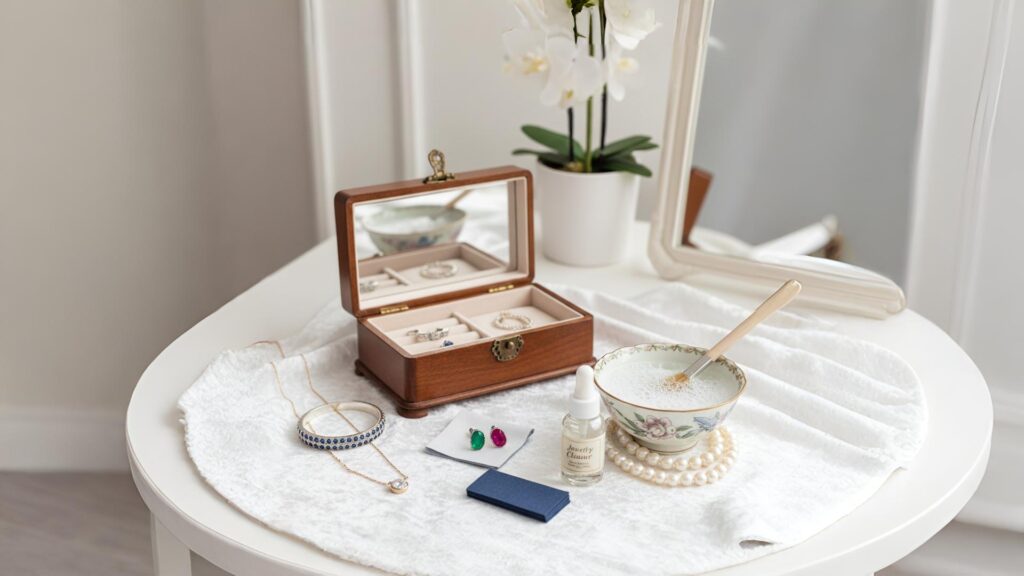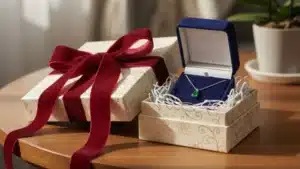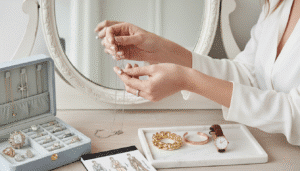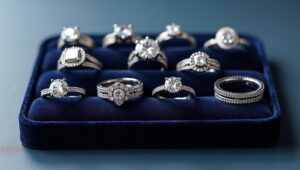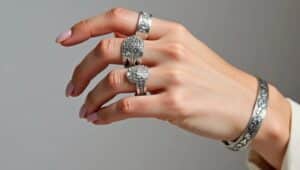Poor jewelry care can reduce your pieces’ value by up to 50% over just a few years. Tarnishing, scratches, loose stones, and chemical damage are not just cosmetic issues; they’re costly problems that proper care can completely prevent.
At MyJewelryCorner, we’ve seen it all: $2,000 necklaces ruined by a single shower, family heirlooms permanently damaged by incorrect cleaning, and expensive pieces lost to preventable wear. But we’ve also witnessed the incredible transformations that happen when people learn the right jewelry care techniques.
In this comprehensive guide, you’ll discover the exact methods professional jewelers use to keep pieces looking flawless for decades. Whether you own a simple fashion ring or a collection of precious heirlooms, these expert jewelry care tips will help your pieces maintain their beauty and value for years to come.
Why Jewelry Care Matters More Than You Think
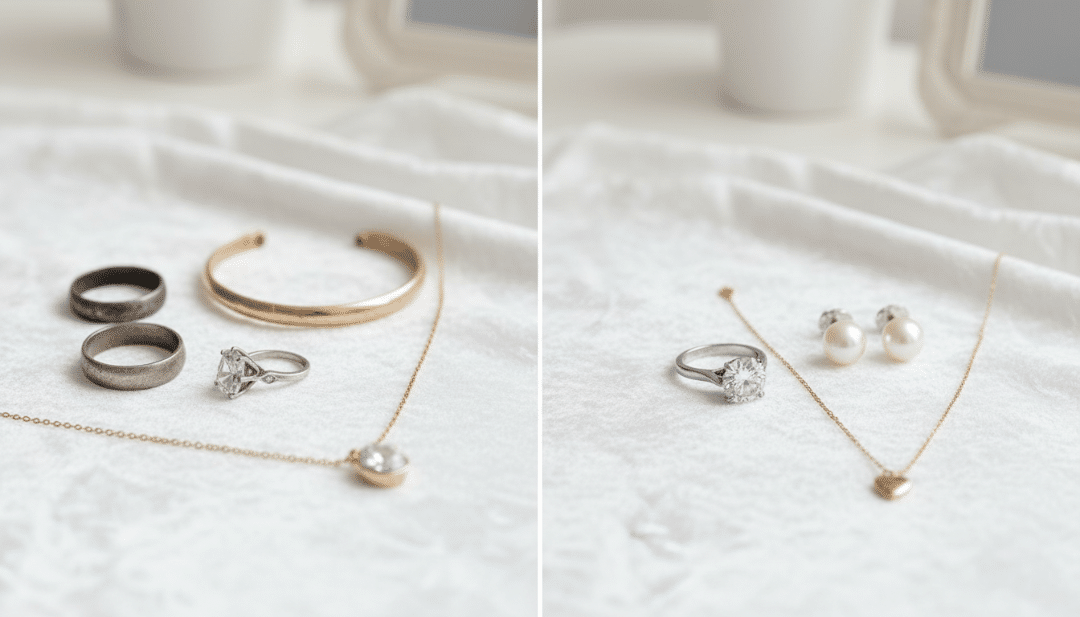
The Hidden Cost of Neglect
Most jewelry owners don’t realize how much damage occurs from everyday wear and improper care. Here’s what’s really at stake:
Financial Impact:
– Tarnished silver can lose 20-30% of its resale value
– Scratched gold requires professional polishing, costing $50-150 per piece
– Loose stones from poor maintenance can result in permanent loss
– Chemical damage to plated jewelry is often irreversible
Beyond the Money: Even more important than financial value is the irreplaceable sentimental worth of your pieces. That engagement ring, the necklace from your grandmother, the earrings you wore on your wedding day; these cannot be replaced at any price.
What Damages Jewelry Daily
Understanding your jewelry’s enemies is the first step in protection:
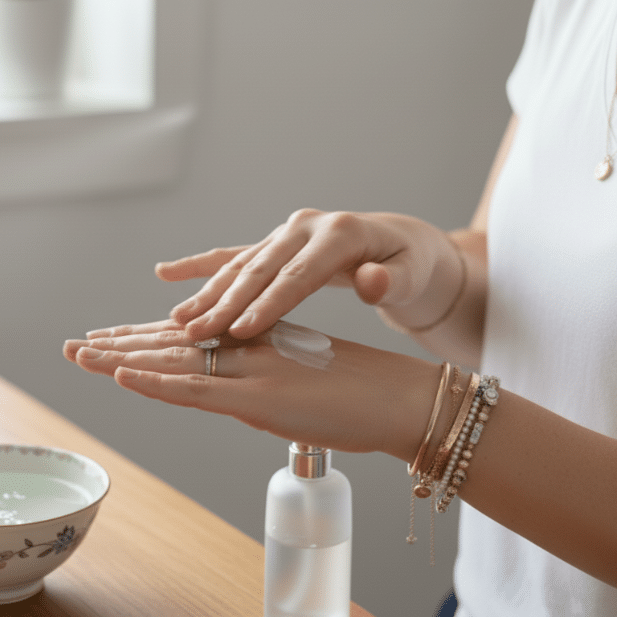
Chemical Damage:
– Perfumes and hairsprays contain alcohol that dulls metal
– Lotions create buildup that attracts dirt and bacteria
– Chlorine in pools literally eats away at gold and silver
– Hand sanitizers can discolor and weaken metal over time
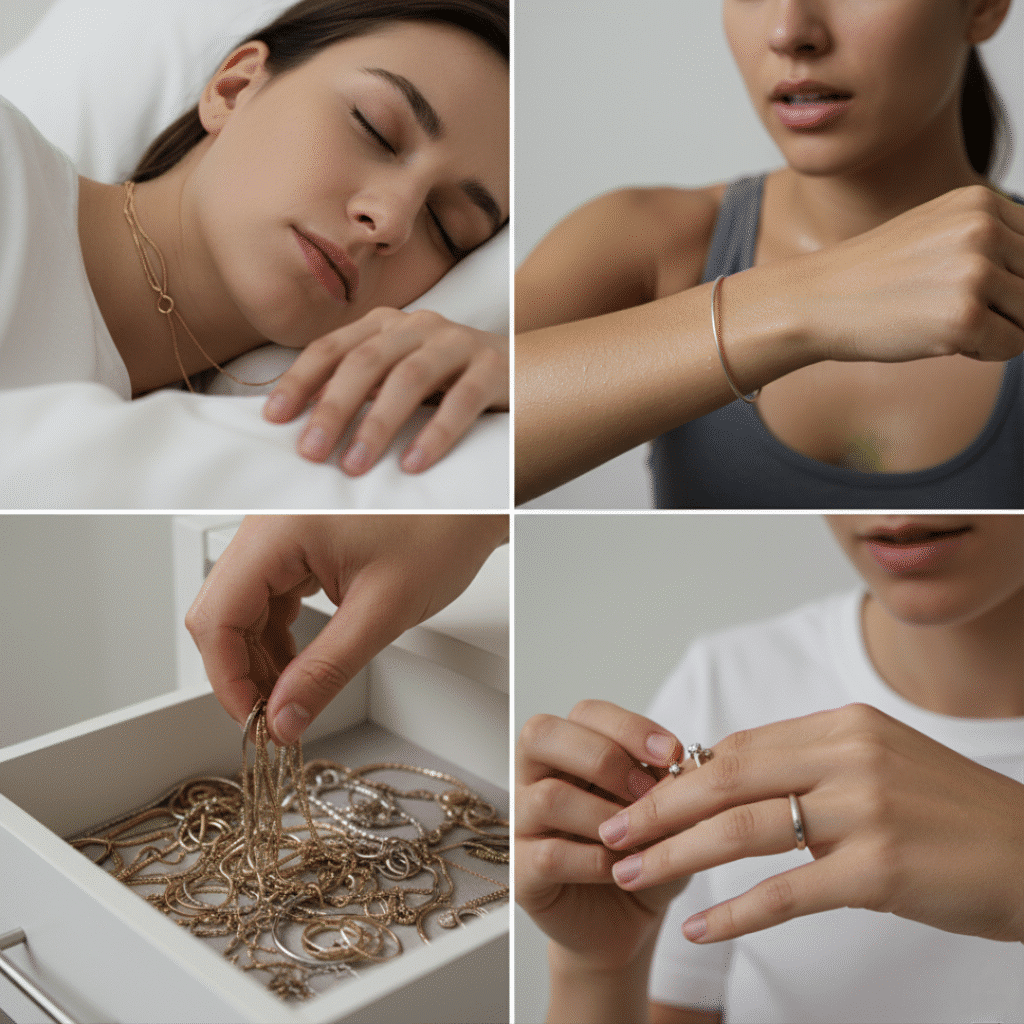
Physical Damage:
– Sleeping in jewelry causes bending and chain stretching
– Exercise exposes pieces to sweat’s corrosive acids
– Improper storage leads to scratches and tangles
– Temperature changes cause metal expansion and stone loosening
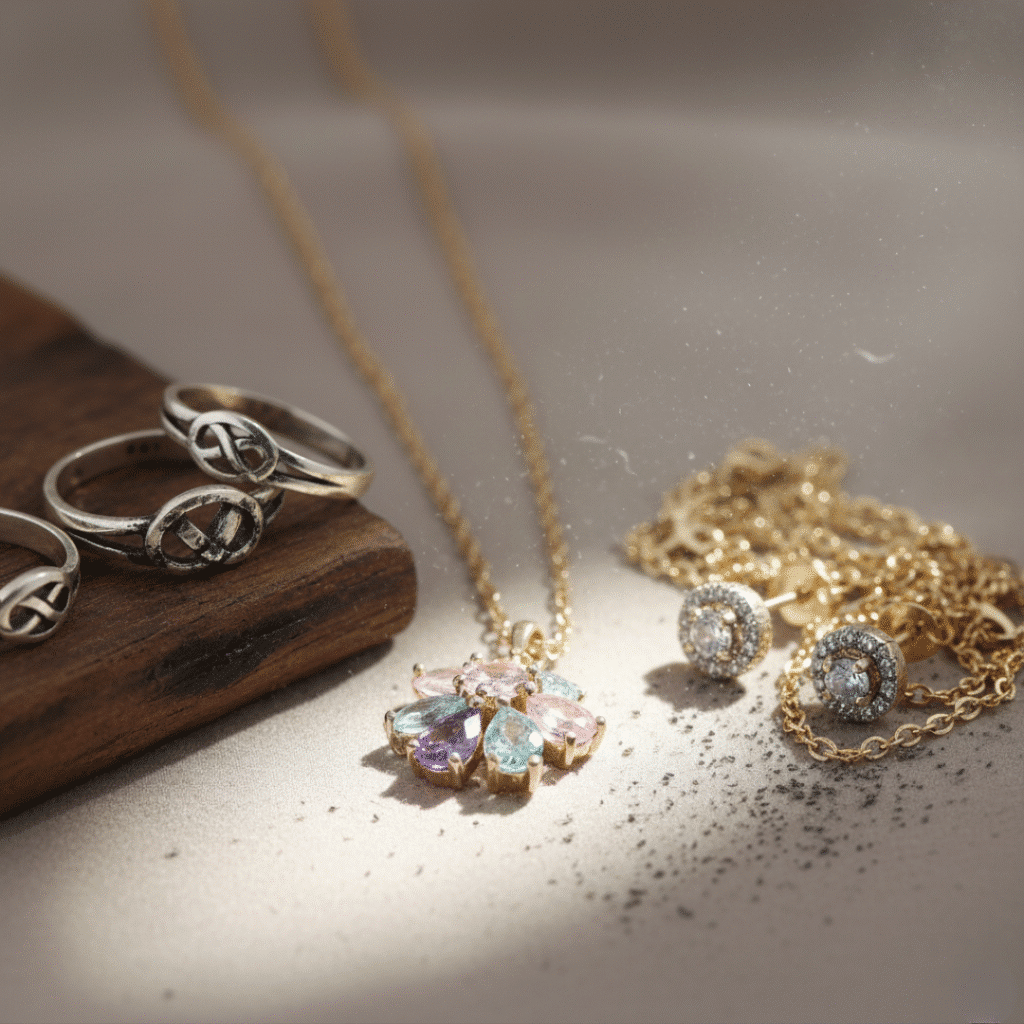
Environmental Factors:
– Humidity accelerates tarnishing in silver
– Sunlight can fade certain gemstones over time
– Air pollution creates a film that dulls surfaces
– Dust and debris accumulate in settings and chains
The good news? Every single one of these problems is completely preventable with the right jewelry care knowledge.
Daily Jewelry Care Habits That Make a Difference
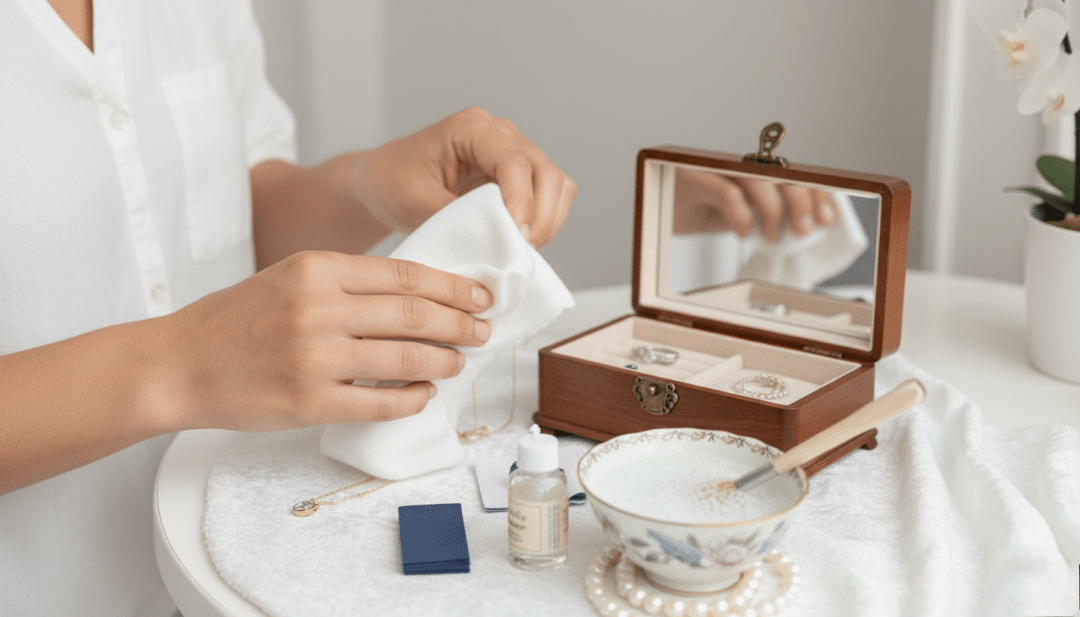
The secret to long-lasting jewelry isn’t complicated cleaning routines or expensive products, it’s developing simple daily habits that become second nature.
Your Morning Jewelry Routine
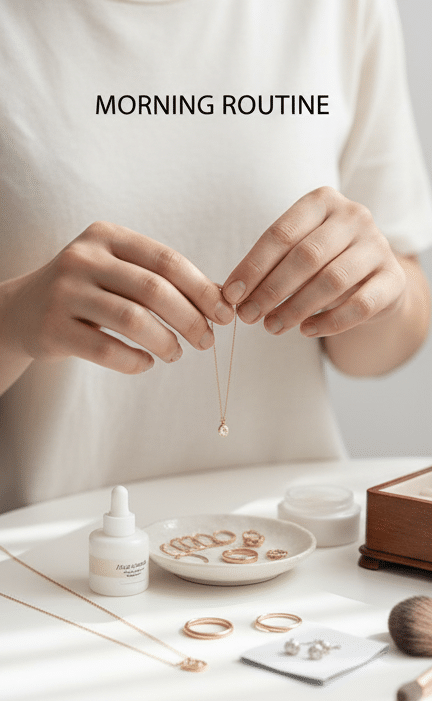
Put Jewelry On Last – Always This single habit will extend your jewelry’s life by years. Here’s the correct order:
1- Shower and dry completely
2- Apply all skincare products and let absorb (5-10 minutes)
3- Apply makeup, including setting spray
4- Style hair with all products
5- Put on jewelry as your final step
Why this matters: Products need time to absorb into skin. Jewelry put on too early becomes a magnet for chemicals that cause long-term damage.
Quick Inspection Habit: Before putting on each piece, take 3 seconds to check:
– Are clasps secure?
– Do stones look tight in their settings?
– Are there any new scratches or damage?
– Does the piece look clean?
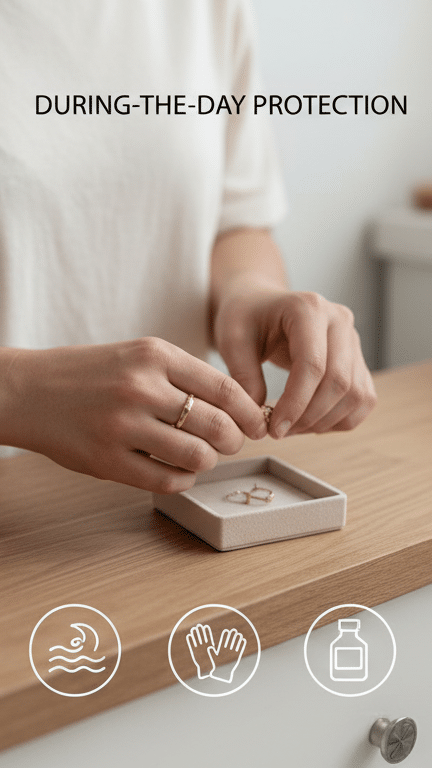
Activity-Specific Guidelines:
Remove jewelry before:
- Swimming (chlorine and saltwater are jewelry killers)
- Exercising (sweat contains acids that corrode metal)
- Cleaning (household chemicals cause permanent damage)
- Cooking (oils and acids can dull surfaces)
- Gardening (dirt scratches and soil chemicals tarnish)
Safe to keep on during:
- Office work (unless handling chemicals)
- Light household tasks
- Driving and commuting
- Dining (away from food prep)
Professional Settings: Your jewelry makes a statement about attention to detail. Clean, well-maintained pieces suggest you care about quality and presentation; important for career advancement.
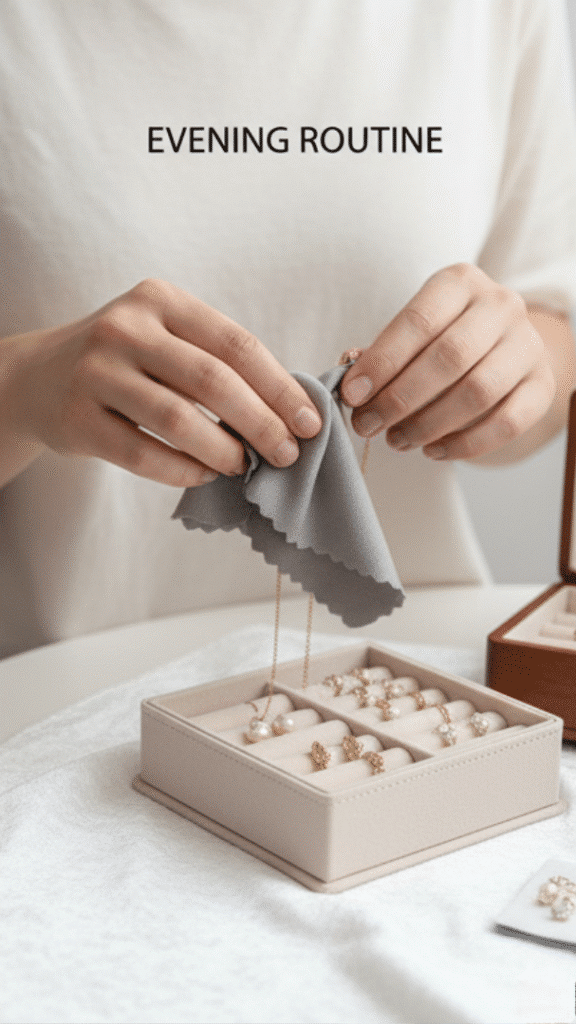
Proper Removal Technique:
1- Remove over a soft surface (bed, carpeted area) to prevent dropping
2- Clean hands first to avoid transferring oils
3- Remove earrings by grasping the back, not pulling the front
4- Lay necklaces flat immediately to prevent tangling
5- Close all clasps to prevent catching and breaking
The 30-Second Evening Clean: For daily-wear pieces, this quick routine prevents buildup:
- – Wipe with a clean, dry microfiber cloth
- – Check for loosening or damage
- – Store properly (we’ll cover this in detail)
Weekly Deep Clean Signal: If your quick wipe reveals:
– Visible residue or dullness
– Buildup around stones or in chain links
– Any discoloration
– Reduced sparkle or shine
It’s time for a proper cleaning (detailed methods coming up).
Travel Jewelry Care
Taking jewelry on trips requires extra thought to keep pieces safe, clean, and damage-free. From packing smart to handling hotel stays and adapting to different climates, a few habits can make a big difference in preserving your collection while traveling.
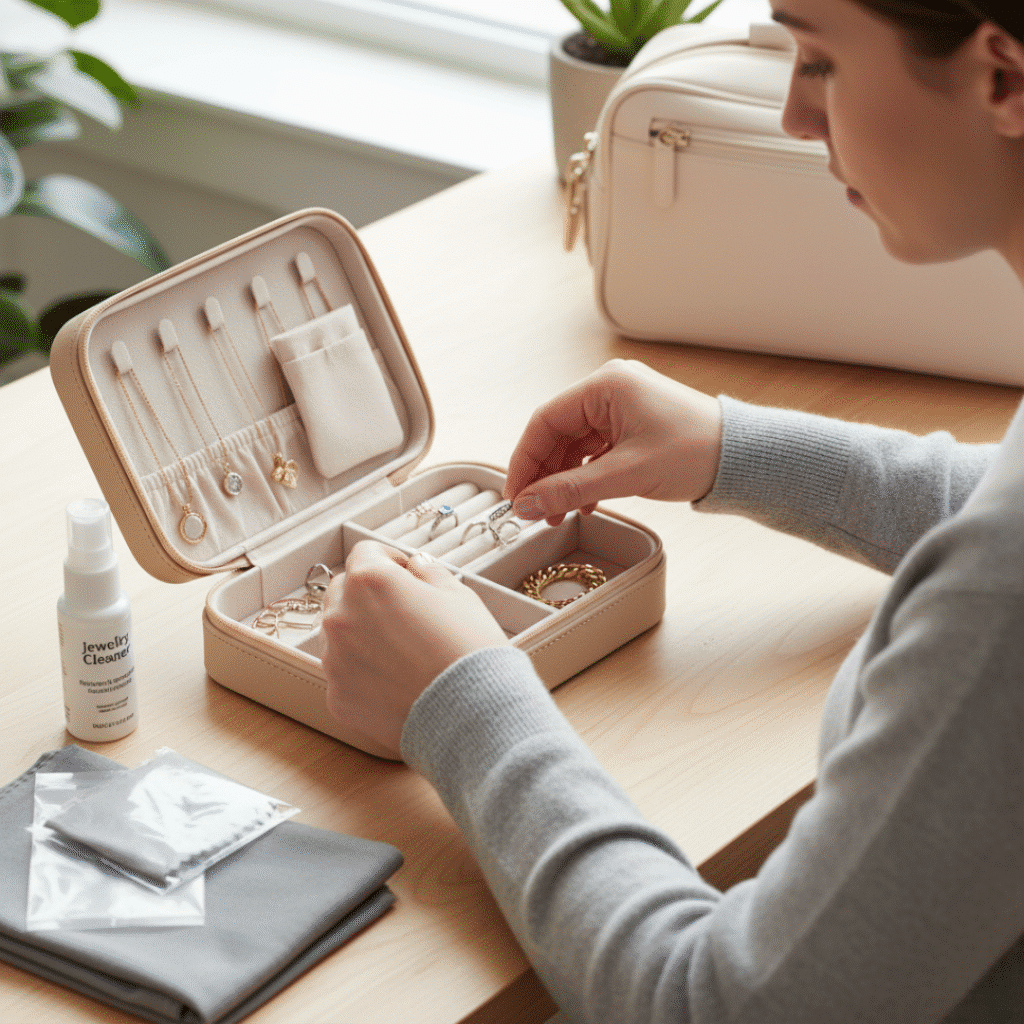
Packing Strategies
– Use a travel jewelry organizer with compartments
– Wrap delicate items in soft cloth
– Pack heavier pieces separately
– Bring small cleaning supplies for longer trips
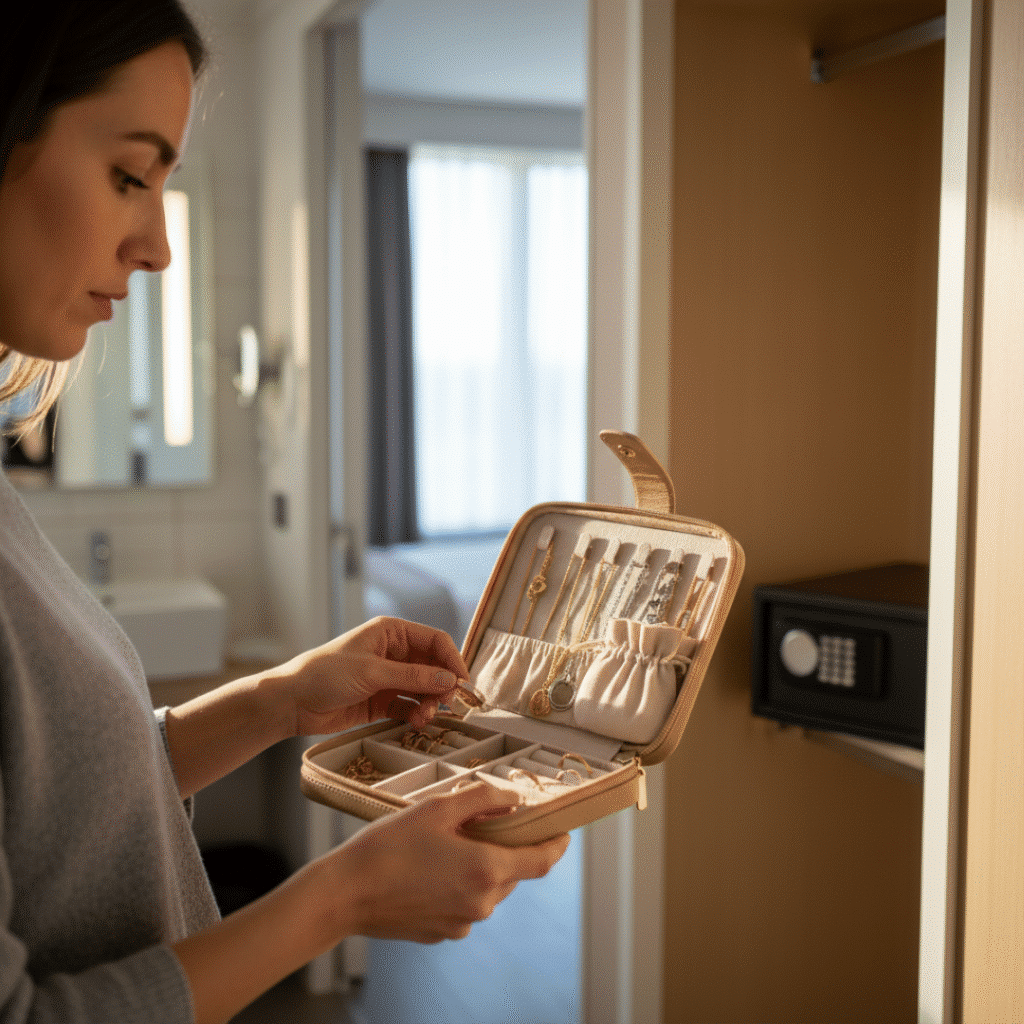
Hotel Care
– Remove jewelry before hotel showers to avoid chemical exposure
– Store valuables in the hotel safe
– Keep pieces away from bathroom humidity
– Inspect jewelry daily for signs of damage
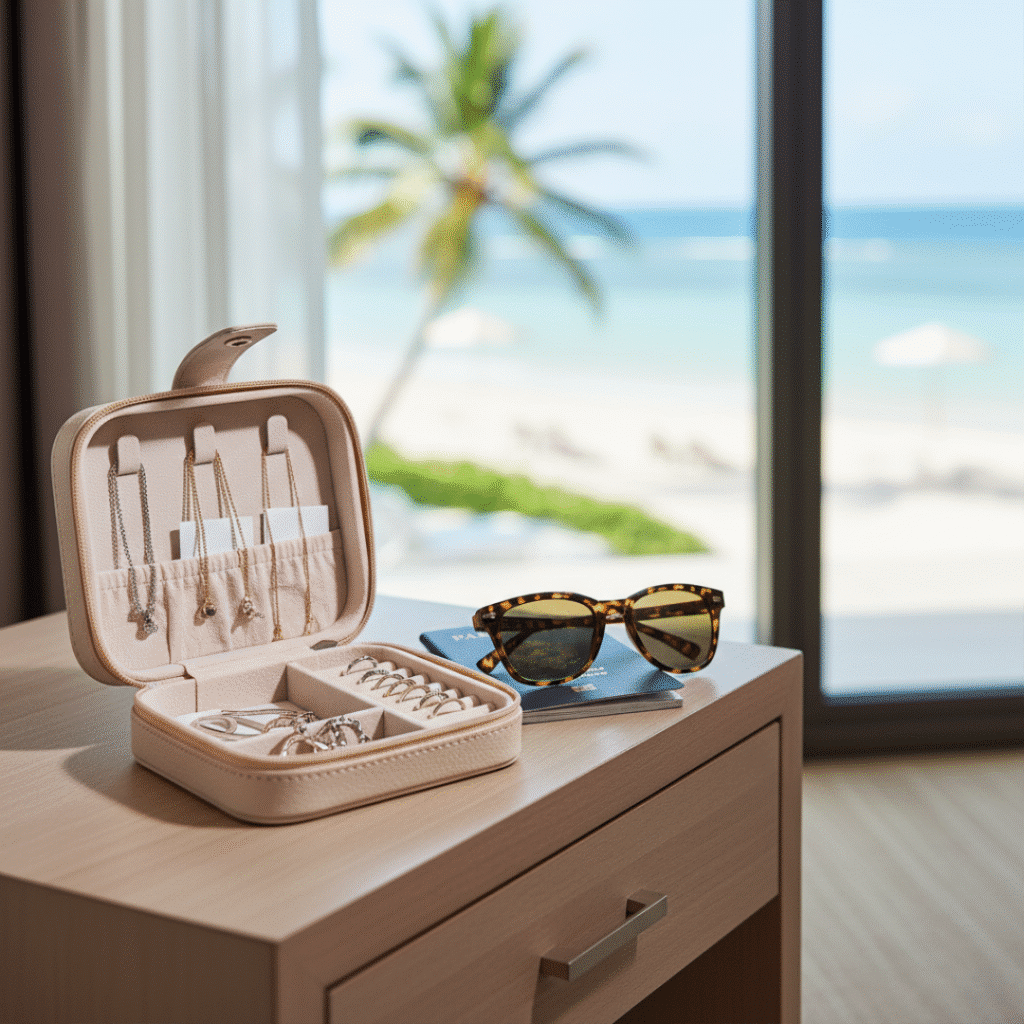
Climate Considerations
– In humid destinations, pack anti-tarnish strips for silver
– In dry climates, handle pearls and other organic materials gently
– For beach trips, leave precious metals at home or store them in the hotel safe
Complete Cleaning Guide by Material Type
Proper cleaning is where most people make costly mistakes. Each jewelry material requires specific care; what works for gold can destroy pearls, and silver cleaning methods can damage gemstones.
Universal Cleaning Supplies You’ll Need
Keeping jewelry clean while protecting its setting and surface requires the right tools and a careful approach. With just a few simple items, you can handle routine cleaning safely and avoid mistakes that cause long-term damage.
Essential Tools
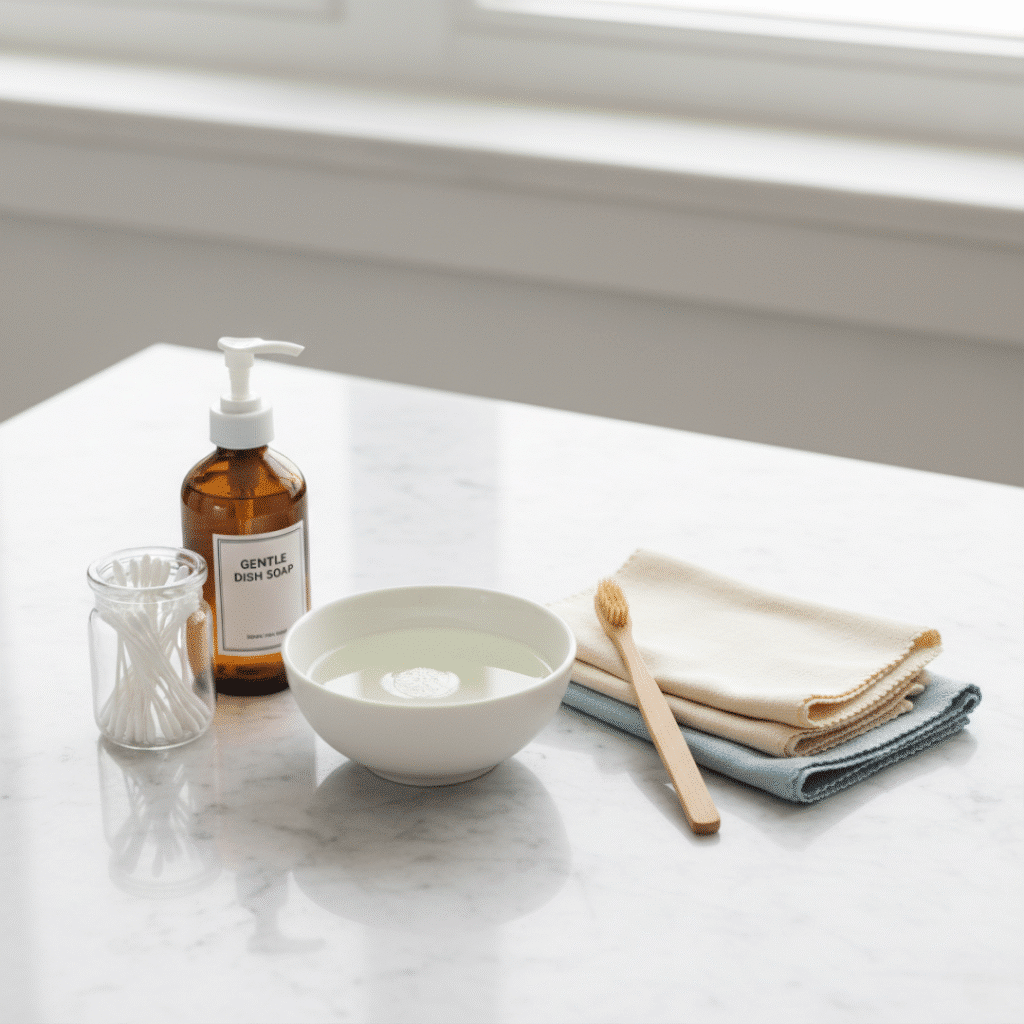
– Soft-bristled toothbrush (unused)
– Lint-free microfiber cloths
– Small bowl for soaking
– Mild dish soap (phosphate-free, no moisturizers)
– Lukewarm distilled water
– Cotton swabs for detailed cleaning
Avoid These Common Mistakes
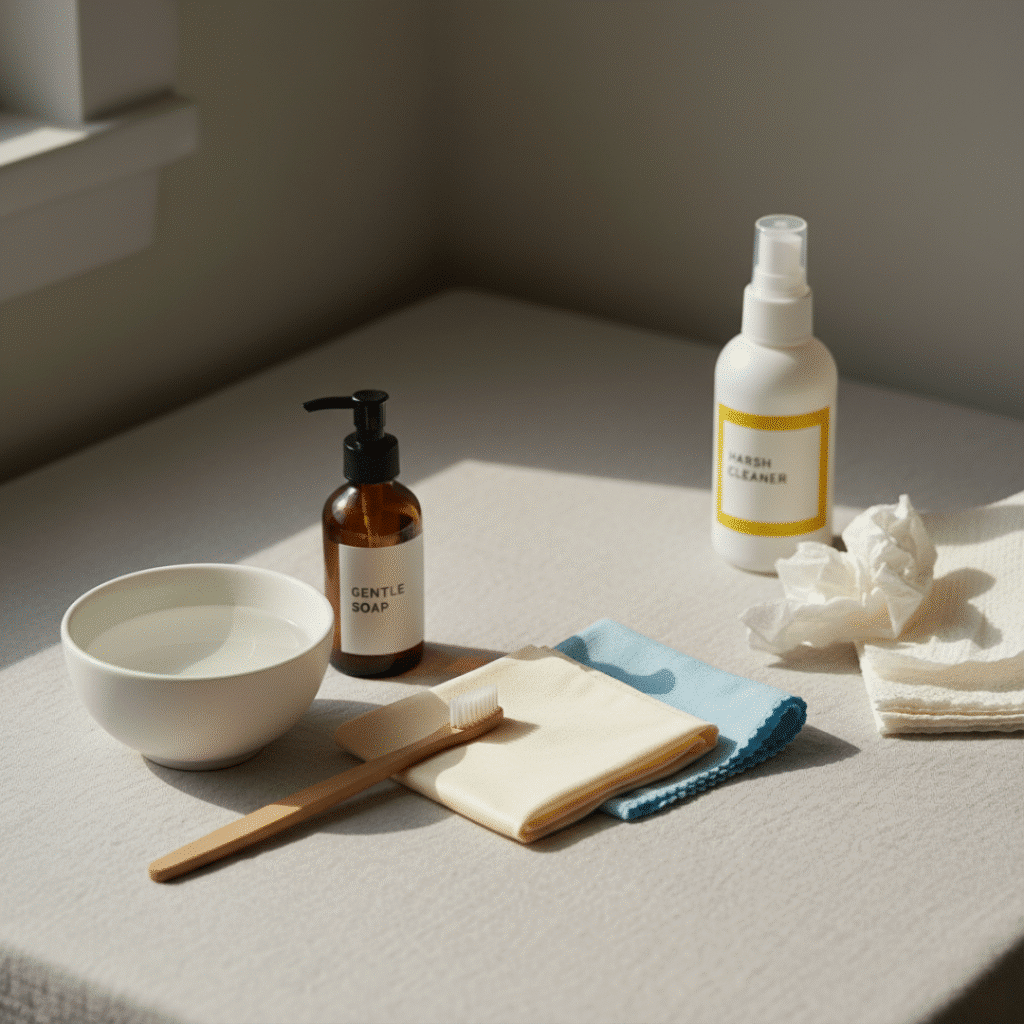
– Do not use hot water (may loosen stone settings)
– Skip ultrasonic cleaners at home (can harm certain stones)
– Avoid household cleaners with harsh chemicals
– Never use tissues or paper towels (they scratch surfaces)
How to Take Care of Gold Jewelry
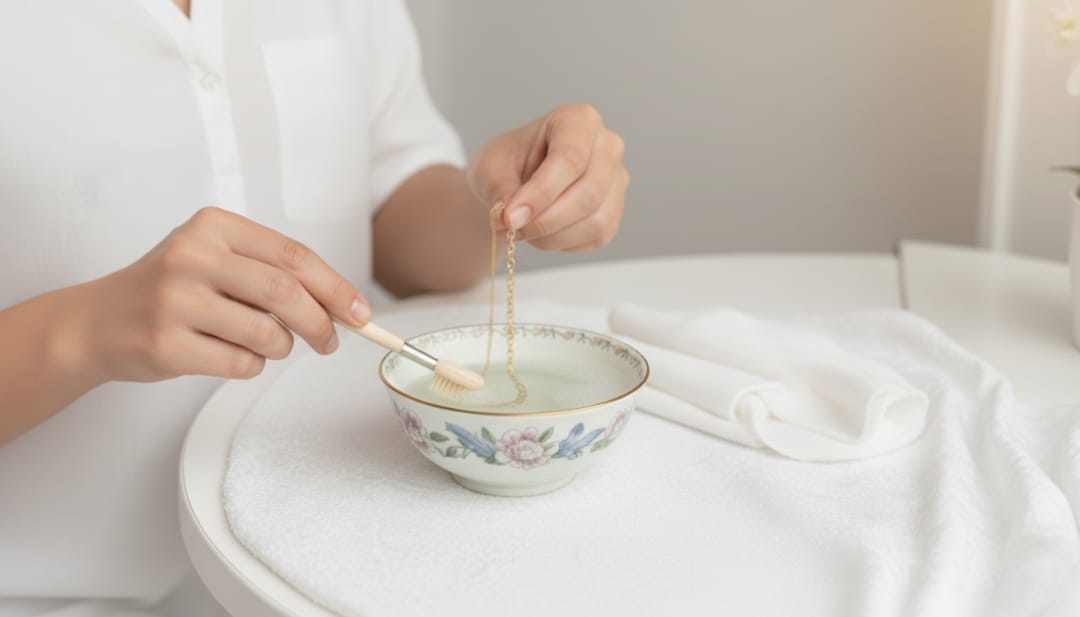
Gold jewelry care depends on whether you have solid gold, gold-plated, or gold-filled pieces.
Solid Gold (14k, 18k, 22k) Cleaning Method:
- – Create cleaning solution: Mix 2-3 drops of mild dish soap in a bowl of lukewarm water
- – Soak for 15-20 minutes to loosen buildup
- – Gentle scrubbing: Use soft toothbrush on chain links and around stones
- – Rinse thoroughly with clean lukewarm water
- – Dry completely: Pat dry with microfiber cloth, never air dry
Frequency: Solid gold can handle weekly cleaning if worn daily.
Pro Tip: For extra shine, use a jewelry polishing cloth specifically designed for gold after cleaning.
How to Take Care of Gold Plated Jewelry
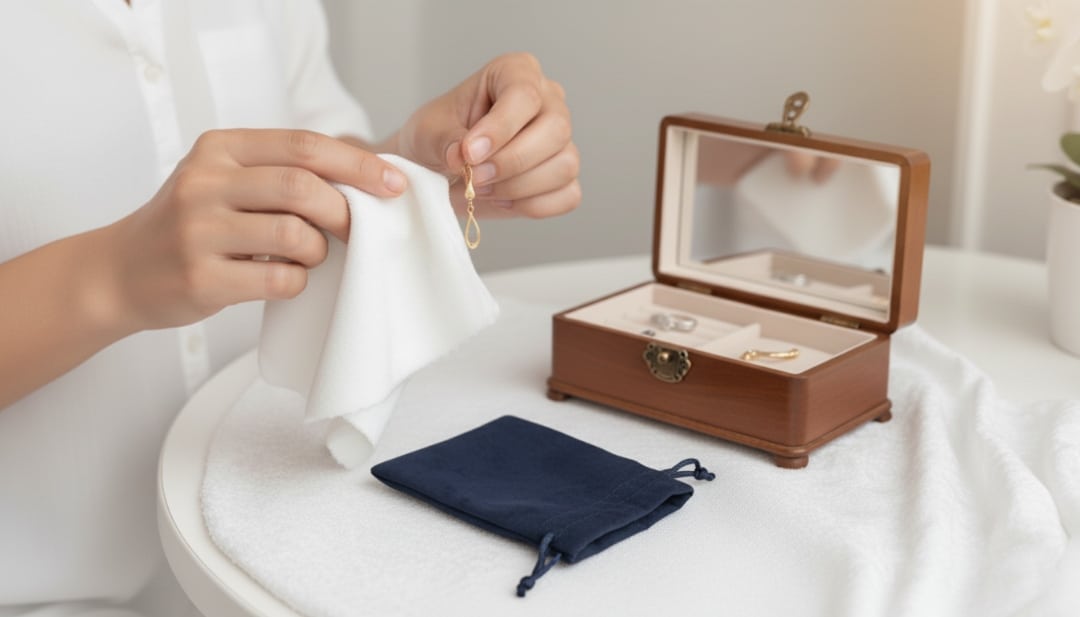
Gold-plated pieces require gentler care since the gold layer is thin and can wear off.
Gold-Plated Cleaning Method:
- – Quick clean only: Use barely damp microfiber cloth
- – Gentle wiping: Follow the direction of any brushed finish
- – Immediate drying: Use dry part of cloth to remove all moisture
- – No soaking ever: water can get under plating and cause bubbling
Special Care for Gold-Plated:
- – Remove before any water contact
- – Store in anti-tarnish bags
- – Replate every 2-3 years for heavily worn pieces
- – Never use jewelry cleaners or polishing compounds
Frequency: Clean after each wear with dry cloth only.
How to Take Care of Stainless Steel Jewelry
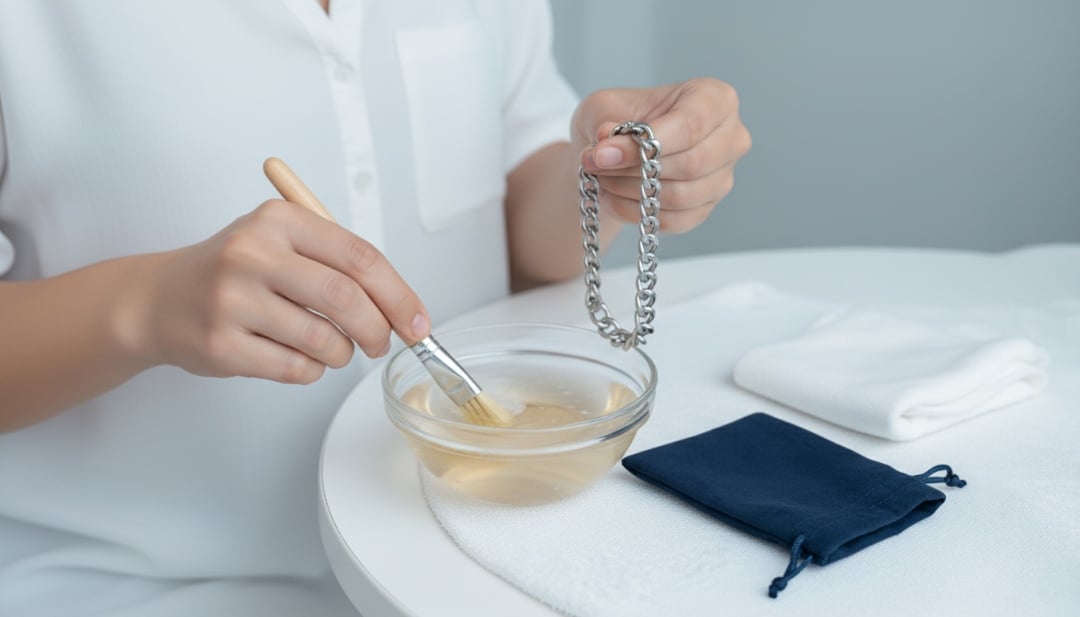
Stainless steel is one of the most durable jewelry materials, but proper care keeps it looking new.
Stainless Steel Cleaning Method:
- – Soap and water: Mix mild soap with warm water
- – Soak briefly: 5-10 minutes maximum
- – Scrub if needed: Safe to use soft brush on stubborn spots
- – Rinse and dry: Thorough drying prevents water spots
- – Polish if desired: Stainless steel polish for extra shine
Stainless Steel Benefits:
- – Won’t tarnish or discolor
- – Hypoallergenic for most people
- – Can handle more aggressive cleaning
- – Resistant to most chemicals
Frequency: Monthly cleaning is usually sufficient.
Sterling Silver Care and Maintenance
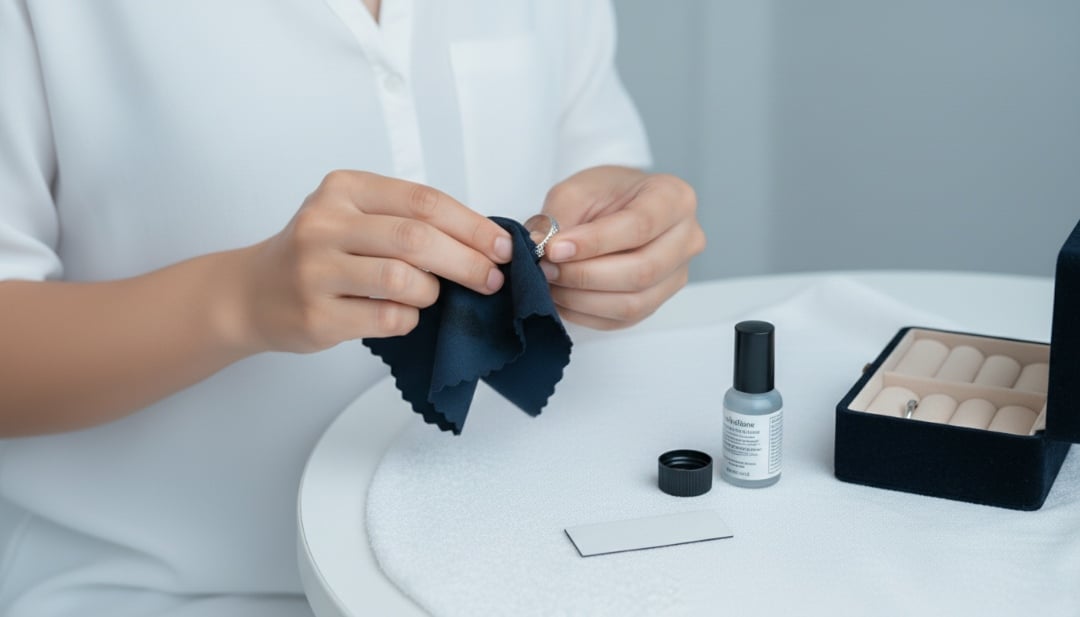
Silver requires the most careful attention due to natural tarnishing.
Silver Cleaning Method:
- – Regular cleaning: Use the universal soap and water method
- – Tarnish removal: Apply silver polish with soft cloth
- – Detailed work: Use cotton swab with polish for intricate areas
- – Final polish: Buff with clean microfiber cloth
- – Protective storage: Store in anti-tarnish environment
Preventing Silver Tarnish:
- – Store with anti-tarnish strips
- – Keep away from rubber and certain plastics
- – Clean regularly before tarnish builds up
- – Consider silver-specific storage solutions
Natural Tarnish Removal: For light tarnish, create a paste with baking soda and water. Apply gently, rinse thoroughly, and dry completely.
Pearl Jewelry Care
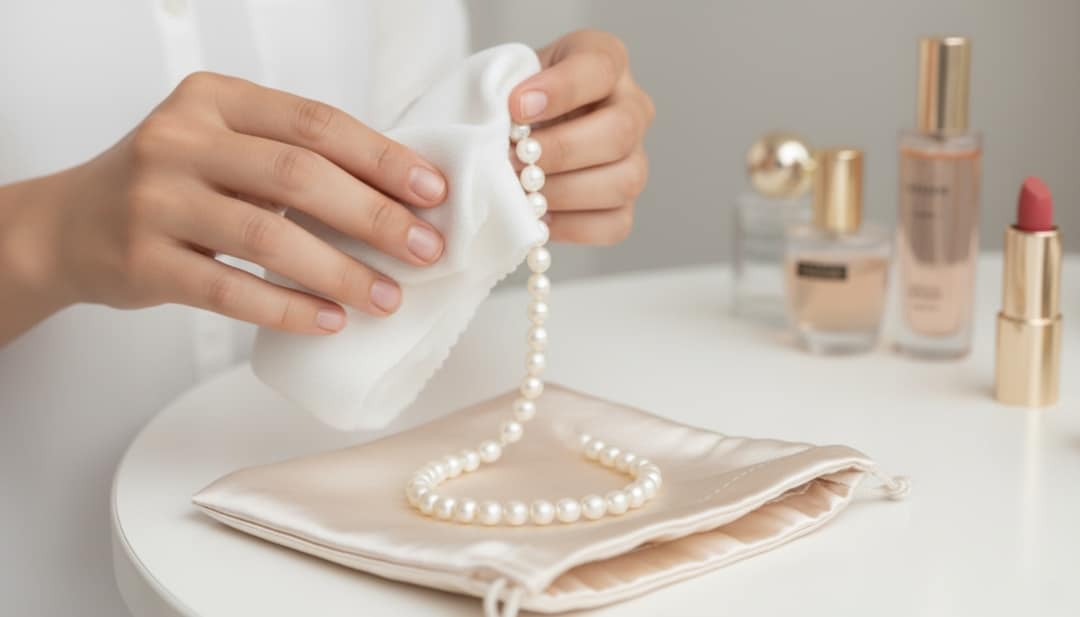
Pearls are organic gems requiring special consideration.
How to Care for Pearl Jewelry:
- – Gentle wipe only: Use barely damp soft cloth
- – Follow grain direction: Wipe along the pearl’s surface, not against it
- – Immediate drying: Never let pearls stay wet
- – No chemicals ever: Water and soft cloth only
- – Professional cleaning: Annual professional care recommended
Pearl Care Rules:
- – Put pearls on last, remove first
- – Store separately from other jewelry
- – Restring every 2-3 years if worn regularly
- – Keep away from cosmetics and perfumes
Signs Your Pearls Need Professional Attention:
- – Dullness that doesn’t improve with gentle cleaning
- – Loose or rough feeling surface
- – Changes in color or luster
- – Stretched or fraying silk string
Gemstone Cleaning by Type
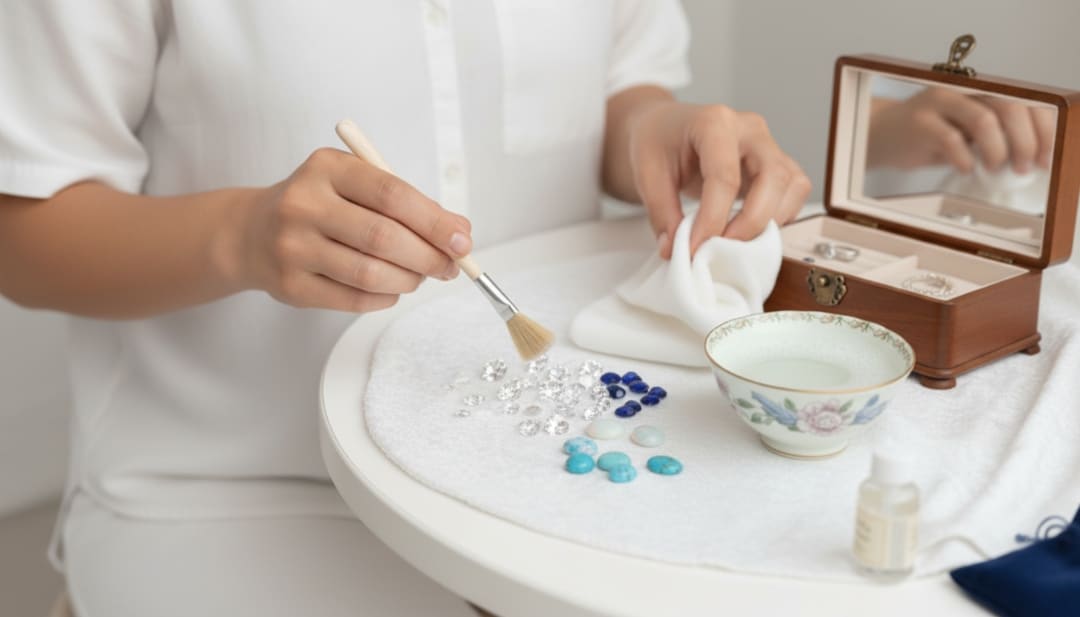
Different gemstones have varying hardness levels and care requirements.
Hard Gemstones (Diamond, Ruby, Sapphire, Emerald):
- – Can handle gentle soap and water cleaning
- – Safe to brush gently around settings
- – Polish with soft cloth after cleaning
- – Professional cleaning recommended annually
Soft Gemstones (Opal, Turquoise, Coral):
- – Dry cloth cleaning only
- – No water or chemicals
- – Store separately to prevent scratching
- – Professional cleaning for any issues
Organic Gems (Amber, Jet, Horn):
- – Minimal moisture, immediate drying
- – No chemicals or perfumes
- – Room temperature storage
- – Professional advice for any problems
Professional Storage Solutions
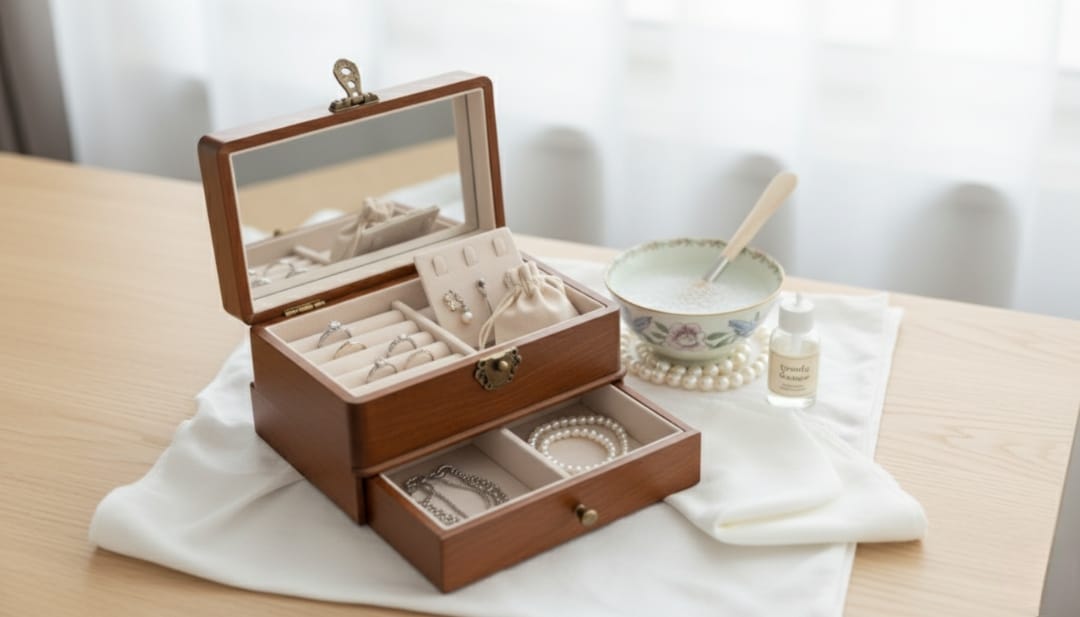
Proper storage prevents more damage than any cleaning routine. Here’s how to store each type of jewelry for maximum protection.
Storage Fundamentals
The Golden Rules:
A few simple principles can keep your jewelry safe, lasting, and easy to maintain. Think of these as the foundation for both storage and everyday care.
- Separate everything: jewelry should never touch other pieces
- Control the environment: keep in cool, dry, and stable conditions
- Ensure easy access: you are more likely to care for jewelry you can see and reach
- Prioritize security: valuable pieces need protective storage
Traditional Jewelry Box Solutions
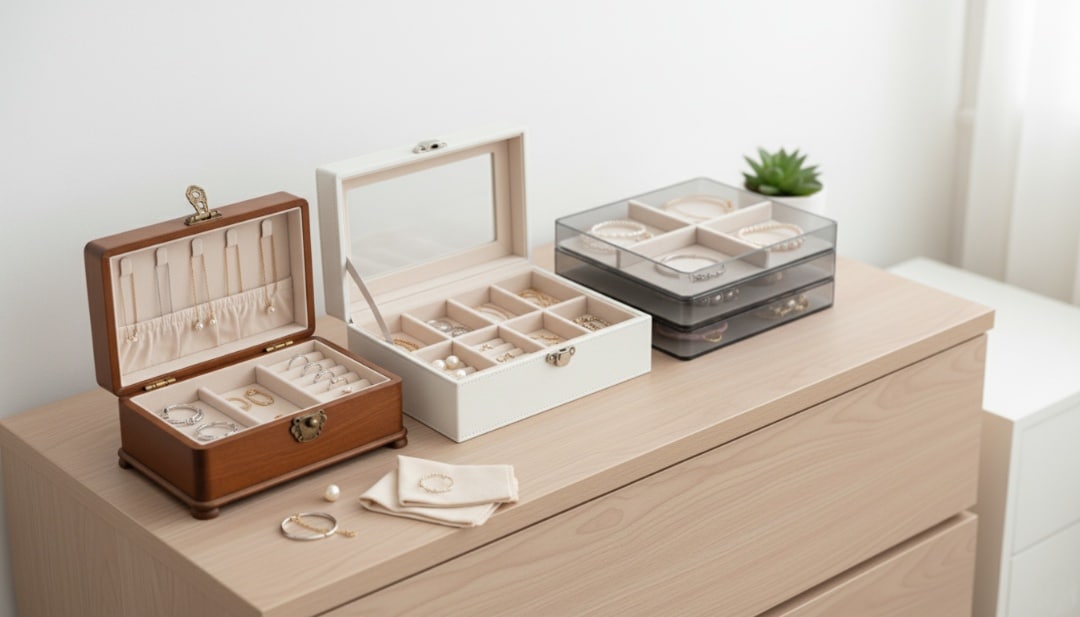
A well-chosen jewelry box is the foundation of safe storage. It not only protects pieces from scratches and dust but also makes daily access more convenient. Different types of boxes suit different needs, from small collections of daily wear to extensive assortments.
- Compartmentalized Boxes
- Best for: Daily-wear jewelry collections
- Features to look for: Soft fabric lining, individual compartments, ring rolls
- Size considerations: Allow room for growth in your collection
- Stackable Organizers
- Best for: Large collections, space-limited areas
- Benefits: Customizable organization, easy to expand
- Drawbacks: Require careful handling when stacked
Modern Organization Systems
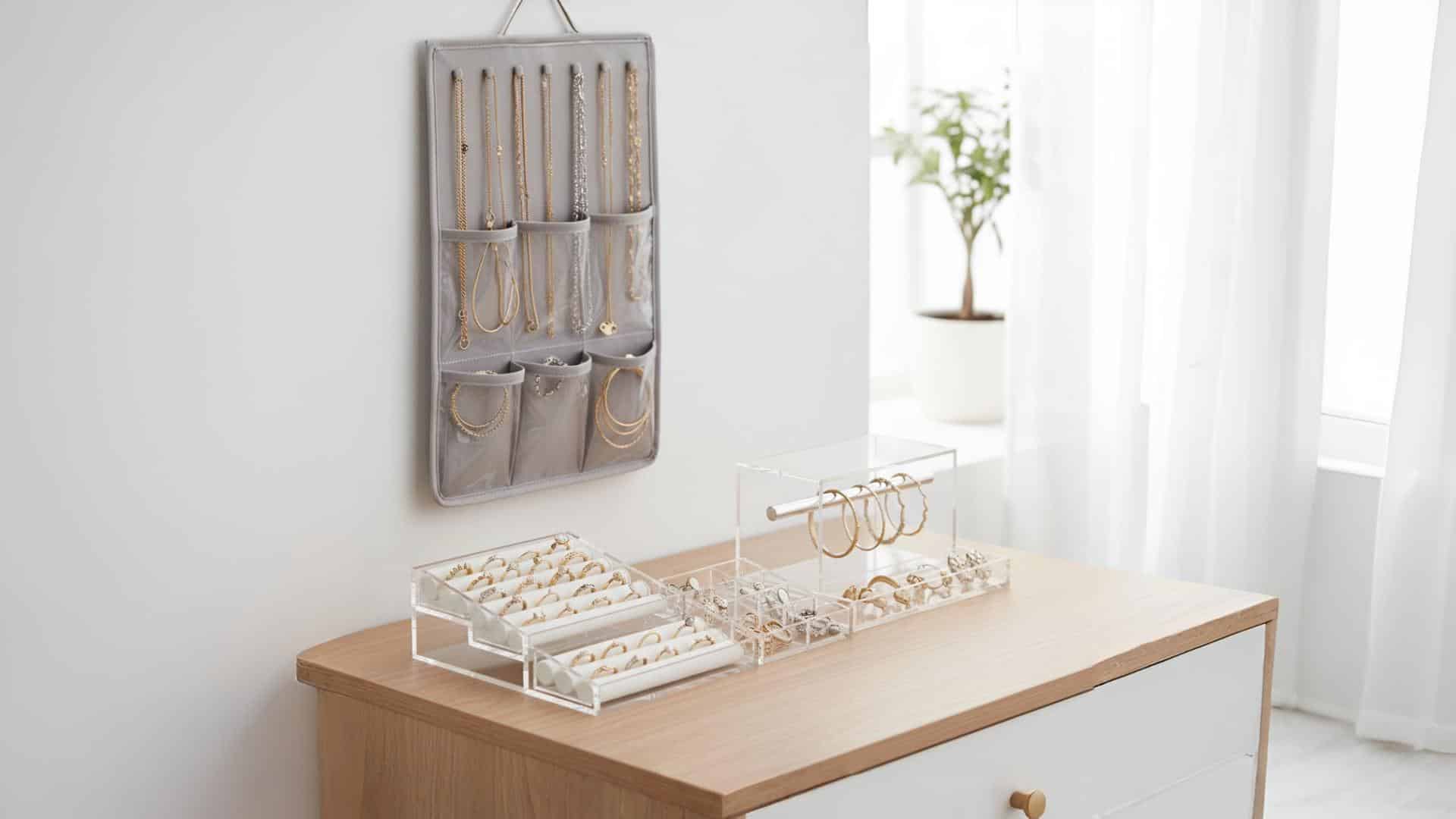
As styles evolve, storage has moved beyond the traditional box. Clear acrylic organizers and hanging systems are designed for people who want quick access to fashion jewelry without sacrificing protection. These options keep collections visible, which encourages regular use and reduces the chance of forgotten pieces.
- Clear Acrylic Organizers
- Advantages: Easy to see all pieces, dust-resistant when closed
- Best for: Fashion jewelry, frequently worn pieces
- Maintenance: Regular cleaning prevents dust buildup
- Hanging Jewelry Organizers
- Perfect for: Necklaces, preventing tangles
- Installation: Inside closet doors, walls, or over doors
- Capacity: Can hold 50+ necklaces in small space
Travel Storage Solutions
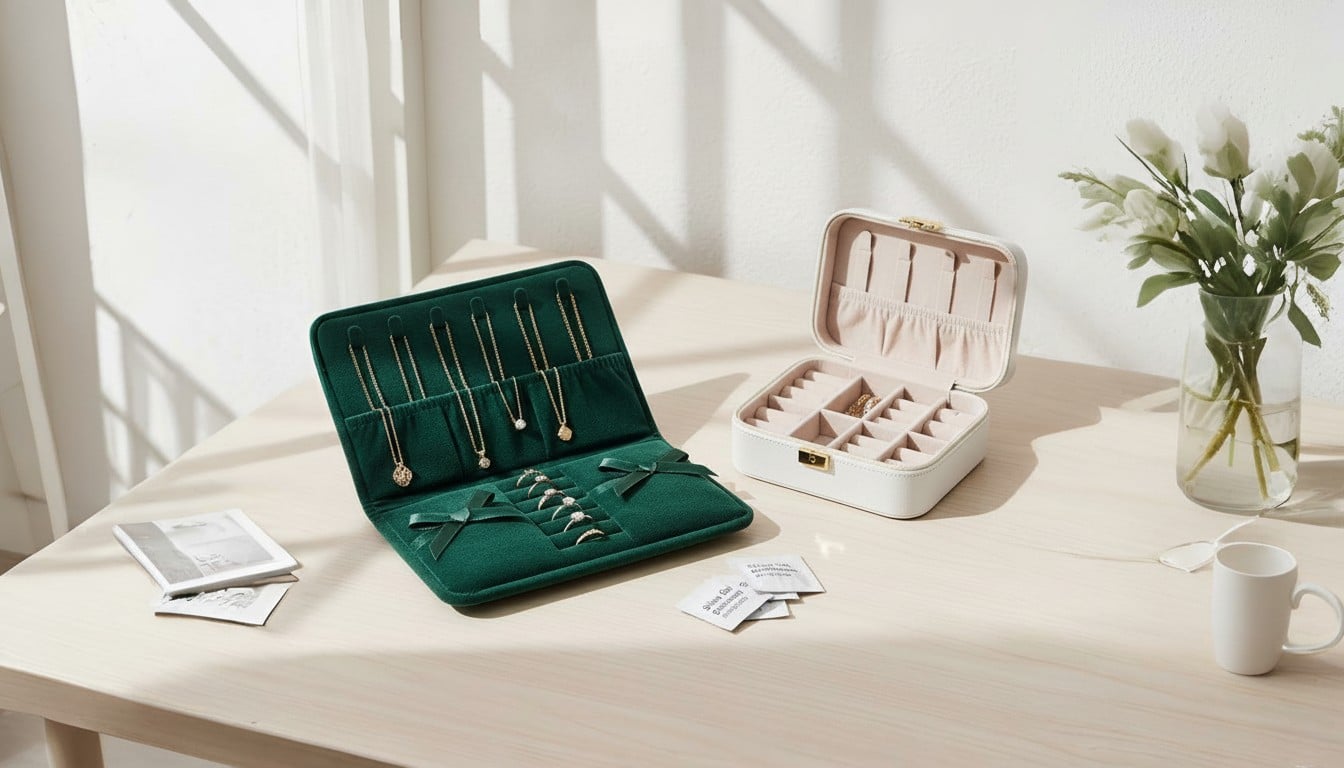
Moving jewelry safely requires specialized storage that balances compactness with protection. Options range from lightweight rolls for short trips to sturdy hard cases for carrying valuable pieces across long distances.
- Jewelry Rolls
- Benefits: Compact, individual compartments, soft protection
- Best for: Short trips, limited pieces
- Materials: Look for silk or velvet lining
- Hard Case Travel Organizers
- Protection level: Maximum security for valuable pieces
- Features: Locking mechanisms, crush-resistant
- Consideration: Heavier but worth it for expensive jewelry
Environmental Control
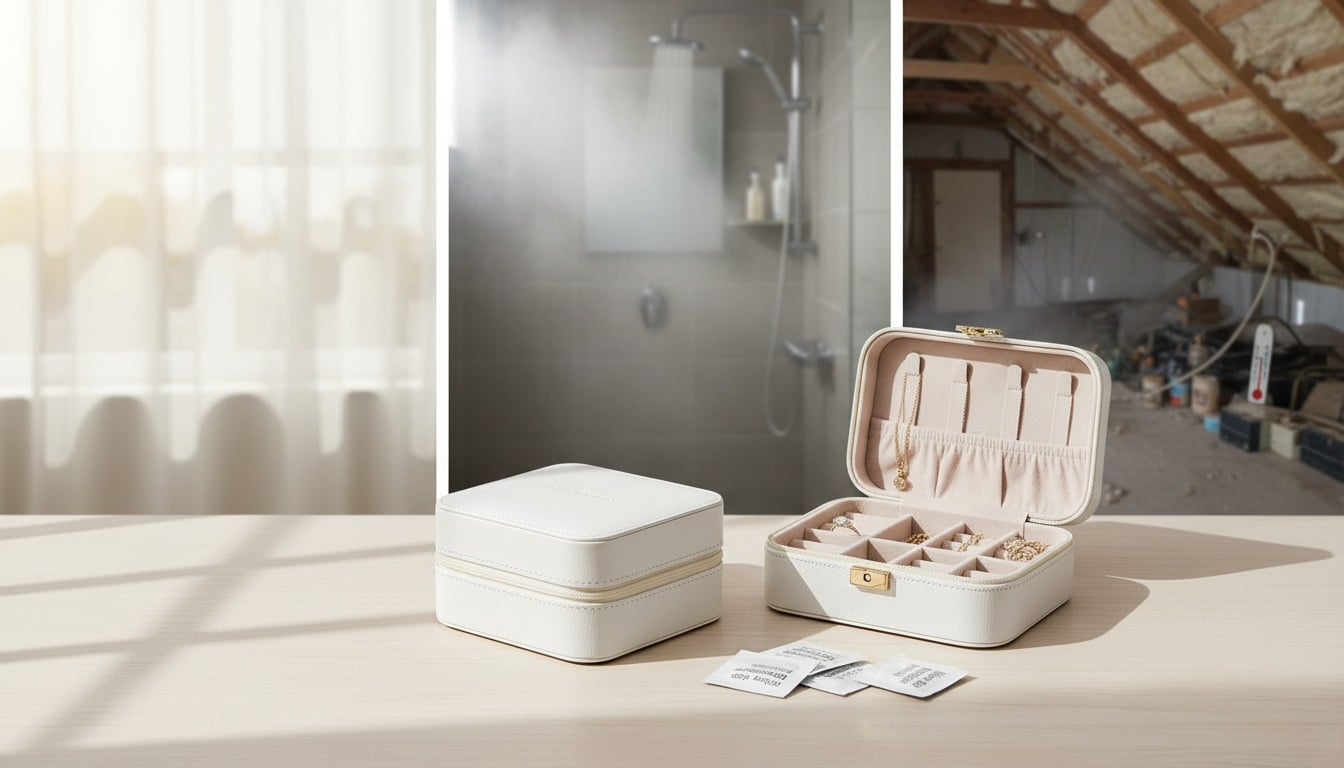
The environment where jewelry is stored can have as much impact as the container itself. Humidity, temperature, and light exposure all influence how well metals and stones hold up over time. Proper control of these elements helps prevent tarnishing, cracking, or fading.
- Humidity Management
- Ideal level: 45–55% relative humidity
- Too dry: Can crack organic materials like pearls
- Too humid: Accelerates tarnishing and corrosion
- Solutions: Silica gel packets, dehumidifiers in storage areas
- Temperature Stability
- Avoid: Areas with temperature fluctuations
- Bad locations: Attics, basements, bathrooms, near heating vents
- Good locations: Bedroom dressers, closets, climate-controlled rooms
- Light Protection
- UV damage: Can fade certain gemstones over time
- Storage: Keep away from windows and direct light
- Display: If displaying jewelry, use UV-protective cases
Organization Systems by Material
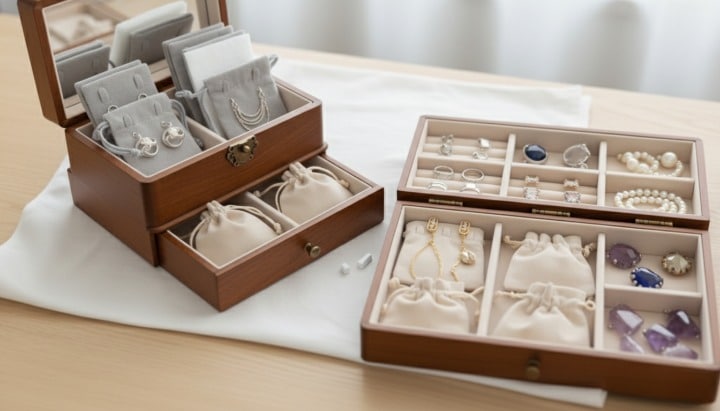
Different materials require tailored care, as what protects silver may harm pearls or gemstones. Following material-specific storage practices ensures longevity and prevents chemical reactions or physical damage.
- Silver Storage
- Anti-tarnish bags or strips are essential
- Individual wrapping in acid-free tissue
- Chalk pieces in storage area absorb moisture
- Never store with rubber (accelerates tarnishing)
- Gold Storage
- Soft pouches prevent scratching
- Separate gold colors (yellow, white, rose) to prevent color transfer
- Chain storage – hang or lay flat, never bunched
- Pearl Storage
- Breathable pouches (pearls need slight moisture)
- Never in plastic bags (can cause cracking)
- Separate from hard stones to prevent scratching
- Flat storage for pearl strands
- Gemstone Storage
- Individual compartments based on hardness
- Soft stones wrapped individually
- Hard stones can be stored together if separated
- Climate consistency crucial for some stones
Troubleshooting Common Jewelry Problems
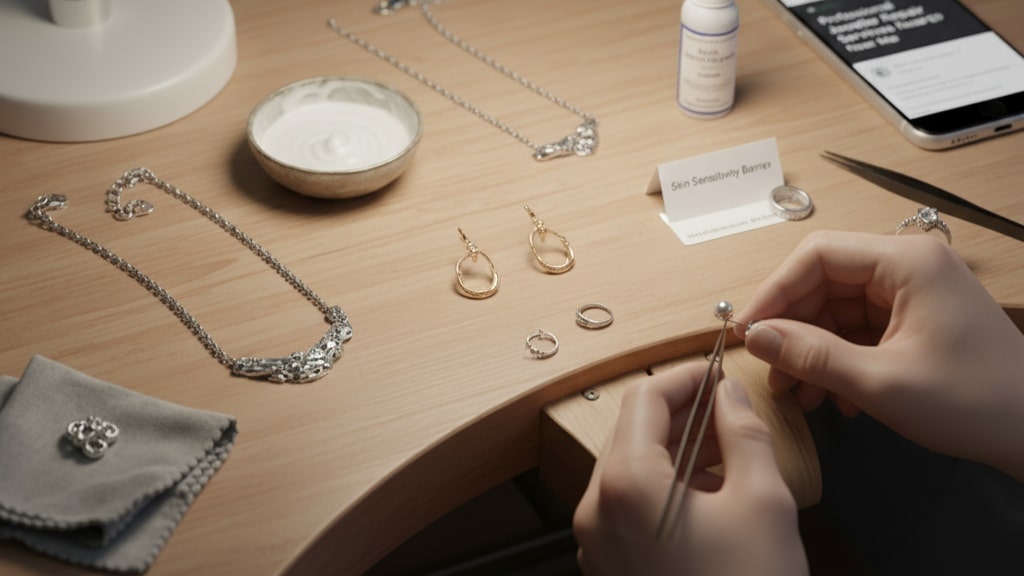
Even with careful storage and routine cleaning, jewelry can develop issues over time. Tarnish, scratches, loose stones, and even skin reactions are part of regular wear. Knowing how to address these problems at home – and when to seek professional help – ensures that your collection remains both wearable and valuable.
Tarnish Removal and Prevention
Tarnish is not simple dirt but the result of a chemical reaction between metal and air. Silver darkens with black or brown discoloration, while copper-based alloys often develop a green hue. Light cases can be managed at home, but heavy tarnish is best left to experts.
DIY Tarnish Removal Method
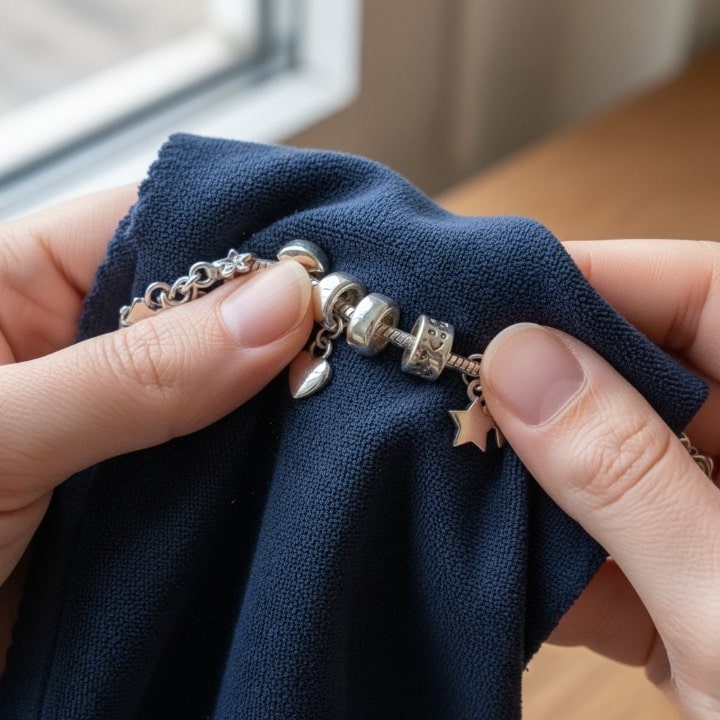
- Light Tarnish (Silver)
- Use a silver-specific polishing cloth
- Polish in gentle circular motions, focusing on small sections
- Build shine gradually with several light passes
- Finish with a clean section of the cloth for a final buff
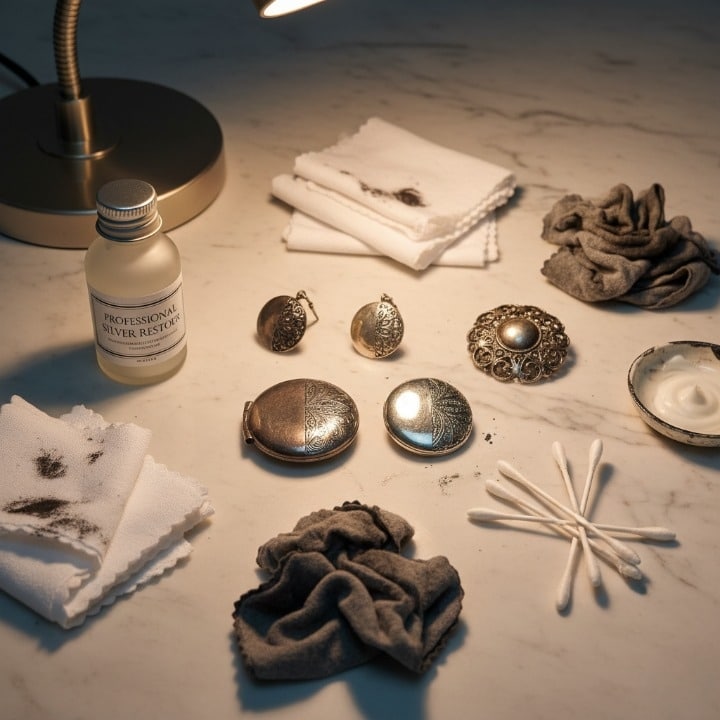
- Moderate Tarnish
- Apply silver polish with a soft cloth
- Allow product to sit for 1–2 minutes
- Remove thoroughly with a clean cloth
- Buff gently to restore shine
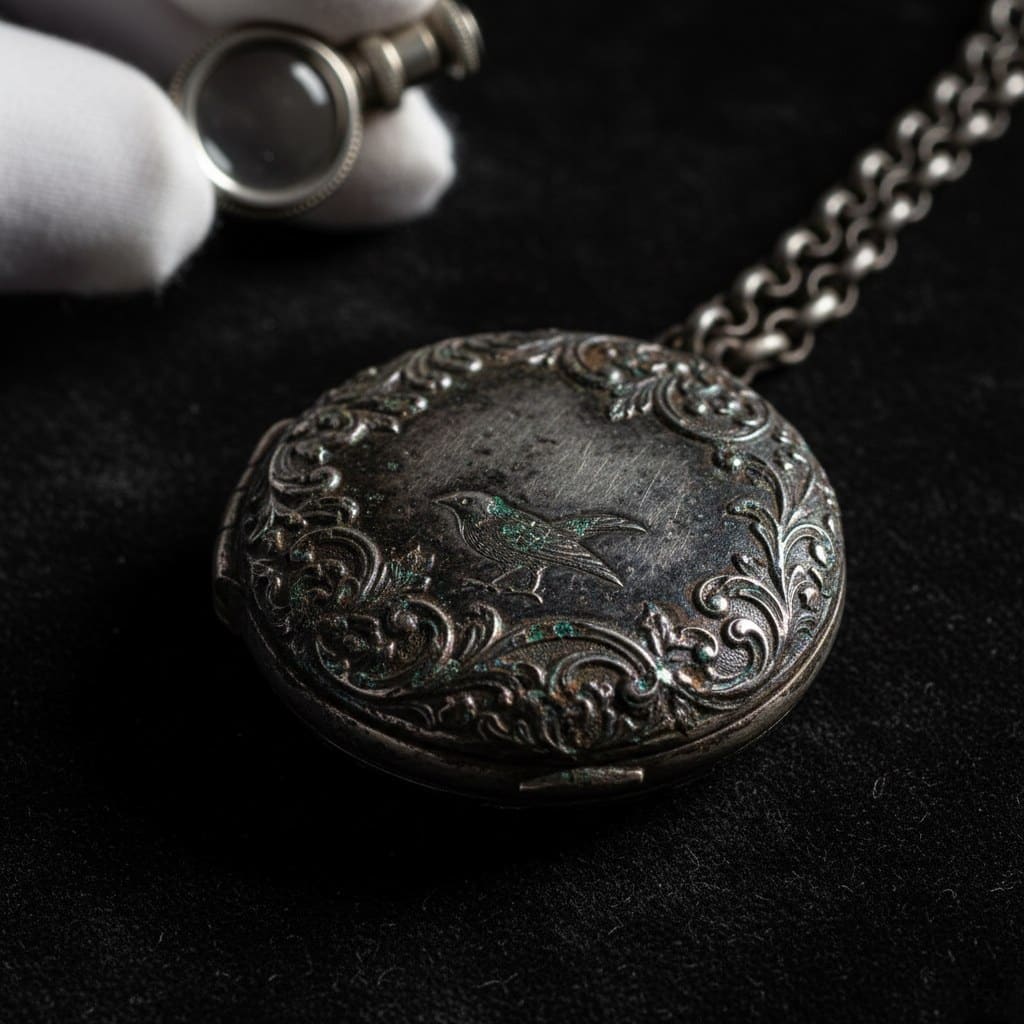
- Heavy Tarnish (Professional Territory)
- Black tarnish unresponsive to polishing
- Tarnish trapped in intricate details
- Discoloration with pitting or rough texture
- Antique or historically valuable pieces
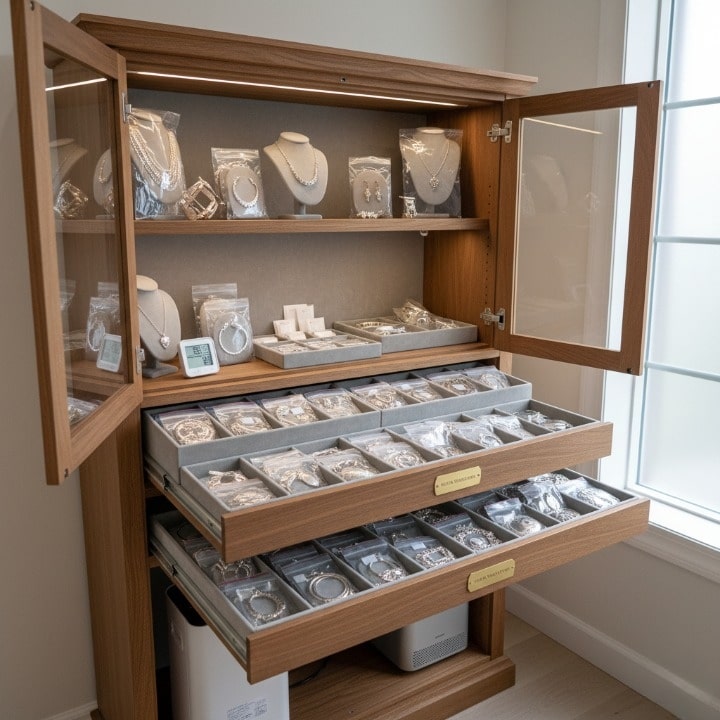
- Preventing Future Tarnish
- Clean jewelry regularly before buildup starts
- Use anti-tarnish strips and bags for storage
- Wear silver often—natural skin oils slow tarnish
- Maintain stable humidity and temperature
Seasonal Care Tips for Year-Round Protection
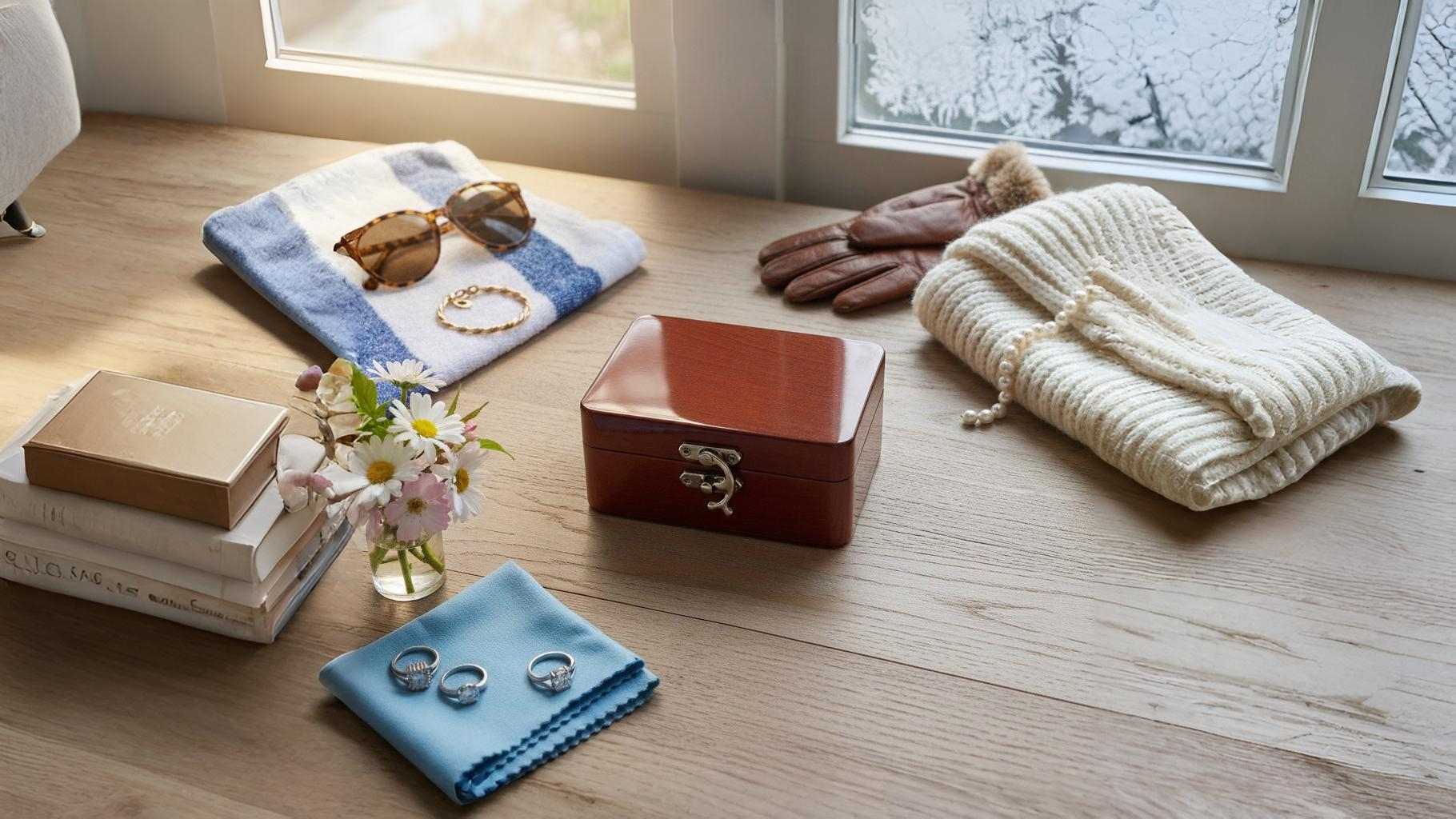
Summer Jewelry Care Tips
Summer is particularly hard on jewelry due to heat, humidity, swimming, and more outdoor activity. Proper precautions can prevent both damage and loss.
- Heat and Humidity Protection
- Heat causes metals to expand, sometimes loosening stone settings
- Humidity accelerates tarnish, especially on silver
- Sweat contains salts and acids that corrode metals
- Swimming and Water Activities
- Always remove jewelry before swimming; chlorine and saltwater are highly damaging
- If exposed, rinse immediately in clean water and dry thoroughly
- Pool chemicals can discolor metals and weaken settings
- Sand can scratch, while salt water accelerates corrosion
- Travel and Vacation Care
- Shifts between air conditioning and outdoor heat can stress metals
- Use travel cases; never pack jewelry loose in luggage
- Leave especially valuable items at home when possible
- Check insurance for travel coverage on expensive pieces
- Summer Activity Guidelines
- Remove jewelry before outdoor sports, gardening, or high-impact activities
- Avoid wearing during beach volleyball, hiking, or crowded events
- Soil, sweat, and impact all increase the risk of damage or loss
Winter Jewelry Protection
Cold weather presents its own challenges, particularly dryness and sudden temperature changes. Extra care is needed for delicate materials and when layering winter clothing.
- Dry Air Effects
- Static electricity can stress fine chain links
- Drier skin may change how rings fit
- Pearls and other organic gems can become brittle
- Temperature Fluctuation Management
- Moving between cold outdoors and heated interiors stresses metal
- Condensation may form on jewelry during these shifts
- Store pieces away from heating vents, drafty windows, or damp areas
- Winter Clothing Considerations
- Wool can scratch surfaces when worn against jewelry
- Scarves often tangle with necklaces
- Gloves may catch on rings or bracelets when removed
- Zippers and coat fastenings can scratch metal and stones
Spring Cleaning and Maintenance
Spring is the ideal season to refresh and reorganize your collection. A thorough cleaning and inspection now helps prevent problems later in the year.
- Annual Deep Cleaning
- Schedule a professional inspection for valuable pieces
- Deep clean jewelry after months of winter storage
- Review condition and note any needed repairs
- Update appraisals and confirm insurance coverage
- Storage Reorganization
- Rotate jewelry: store heavy winter pieces, bring out lighter ones
- Check anti-tarnish strips and replace as needed
- Reorganize storage to match current style preferences
- Invest in new storage if your collection has grown
Your Monthly Jewelry Care Checklist
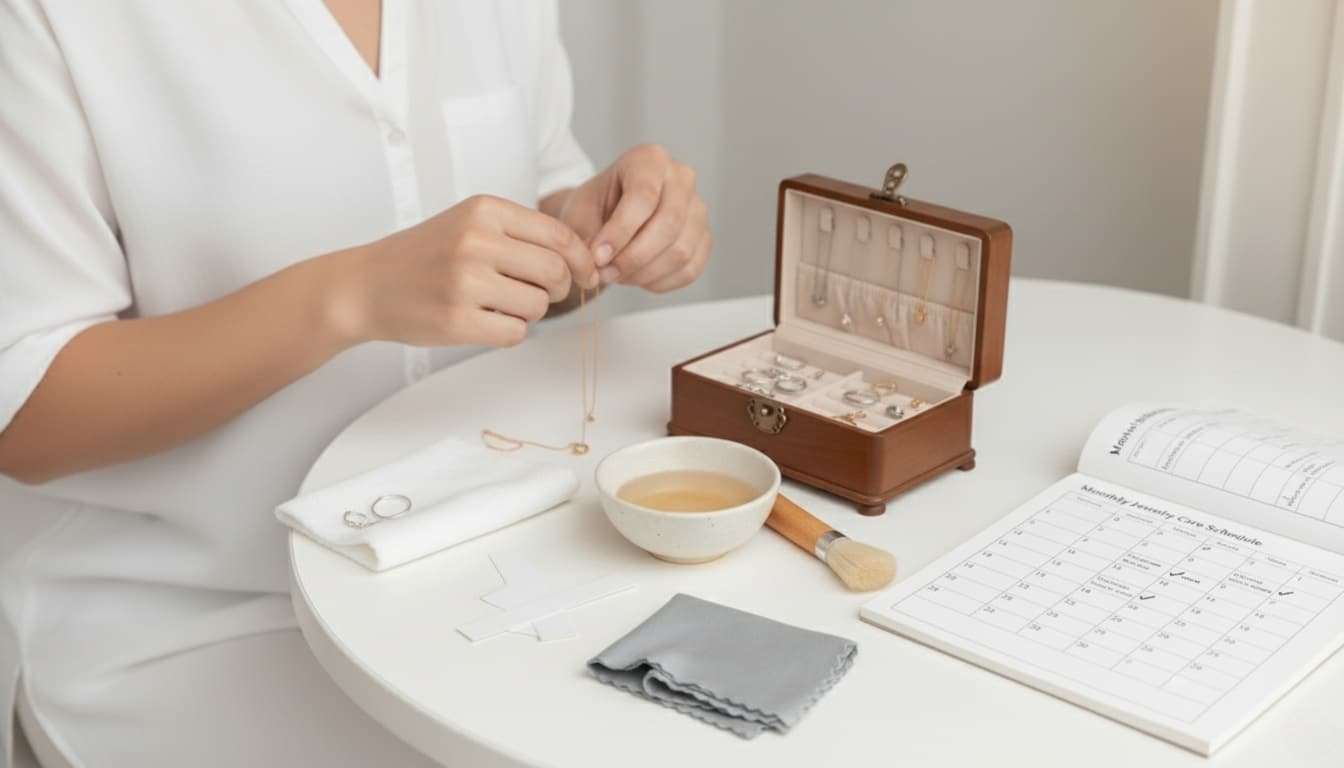
Consistent care is more effective than occasional deep cleaning. Use this checklist to maintain your collection systematically.
Weekly Tasks (5-10 minutes)
For Daily-Wear Pieces:
- Quick inspection: Check for loose stones, damaged clasps, or new scratches
- Gentle cleaning: Wipe with soft, dry microfiber cloth
- Proper storage: Ensure pieces are stored correctly when not worn
- Rotation check: Rotate frequently worn pieces to prevent over-wear
For All Jewelry:
- Storage environment: Check humidity levels, ensure proper temperature
- Organization maintenance: Keep pieces separated and organized
- Security check: Verify valuable pieces are properly secured
Monthly Deep Care (30-45 minutes)
Cleaning Schedule:
- Gold jewelry: Complete cleaning using soap and water method
- Silver pieces: Polish and treat any early tarnish signs
- Stainless steel: Thorough cleaning and polishing if needed
- Pearl jewelry: Gentle wipe and inspection for string wear
- Gemstone pieces: Appropriate cleaning based on stone type
Maintenance Tasks:
- Clasp functionality: Test all clasps and closures
- Chain inspection: Look for weak links, kinks, or wear
- Stone security: Gently test prong tightness (don't force)
- Fit assessment: Ensure pieces still fit comfortably and securely
Storage Maintenance:
- Replace anti-tarnish strips: Change every 6-12 months
- Clean storage containers: Dust and wipe down jewelry boxes
- Reorganize if needed: Adjust organization as collection changes
Quarterly Professional Care (Every 3 Months)
For High-Value Pieces:
- Professional inspection: Have valuable pieces checked by jeweler
- Deep cleaning service: Professional cleaning for pieces that need it
- Repair assessment: Address any issues before they worsen
- Insurance review: Ensure coverage is adequate and current
For All Jewelry:
- Comprehensive inventory: Complete listing with photos
- Condition assessment: Note any changes or needed attention
- Storage evaluation: Assess and improve storage solutions as needed
- Care routine review: Adjust care habits based on results
Documentation Updates:
- Photography refresh: New photos for insurance and records
- Inventory verification: Confirm all pieces are accounted for
- Insurance review: Update coverage and valuations
- Will/estate planning: Ensure jewelry is properly documented for estate purposes
Seasonal Adjustments
Spring Preparation:
- – Post-winter assessment: Check for dry air damage
- – Storage refresh: Clean and reorganize after winter
- – Professional appointments: Schedule annual services
- – Inventory update: Prepare for more active wearing season
Summer Preparation:
- – Heat/humidity protection: Adjust storage for summer conditions
- – Travel planning: Prepare travel jewelry and security measures
- – Activity adjustment: Plan jewelry choices for summer activities
- – Cleaning supply check: Ensure adequate supplies for increased wear
Fall Preparation:
- – Summer damage assessment: Check for vacation and activity damage
- – Climate transition: Adjust storage for changing conditions
- – Holiday preparation: Plan and prepare pieces for holiday season
- – Professional repair scheduling: Address summer damage before holiday wear
Winter Preparation:
- – Dry air protection: Add humidity control measures
- – Storage adjustment: Prepare for less frequent wear of some pieces
- – Heavy jewelry care: Special attention to pieces worn with winter clothing
- – Holiday jewelry preparation: Clean and inspect formal pieces
Conclusion:
Your jewelry represents more than just beautiful accessories – each piece tells a story, marks a moment, or carries sentimental value that can’t be replaced. When you choose jewelry wisely and pair that decision with the comprehensive jewelry care knowledge you’ve gained from this guide, you now have the power to keep those stories alive and those memories sparkling for generations to come.
Remember the Key Principles:
- Prevention is always better than correction – simple daily habits prevent costly problems
- Each material has specific needs – what works for gold can damage pearls
- Professional help is an investment – expert care protects valuable and sentimental pieces
- Consistency matters more than perfection – regular basic care beats occasional deep cleaning
Your Next Steps:
- Assess your current collection using the guidelines in this article
- Implement the daily habits that will make the biggest difference
- Schedule professional inspections for your most valuable pieces
- Create your personalized care routine using our monthly checklist
At MyJewelryCorner, we’re committed to helping you protect and enjoy your jewelry investment. Every piece in our collection is designed to last, but proper care ensures they’ll continue bringing you joy for years to come.
Need personalized advice for your specific pieces? Our jewelry care experts are here to help.
FAQs:
General Jewelry Care
Daily-wear pieces should be wiped clean after each wear and deep cleaned weekly. Occasionally worn pieces need cleaning monthly or as needed. The frequency depends on your skin chemistry, activity level, and environmental exposure.
It depends on the material. Solid gold and platinum can handle occasional water exposure, but it’s not recommended regularly. Never shower with: pearl jewelry, gold-plated pieces, costume jewelry, or pieces with gemstones that can be damaged by water. The safest practice is removing all jewelry before showering.
Gold-filled jewelry has a thick layer of gold mechanically bonded to a base metal (typically 5% of the total weight), while gold-plated has a thin electroplated layer. Gold-filled lasts 10-30 years with proper care, while gold-plated may wear off in 6 months to 2 years. Gold-filled can handle gentle cleaning; gold-plated requires only dry cloth cleaning.
Green discoloration comes from copper in metal alloys reacting with moisture, acids, and oxygen. This happens with lower-quality metals or when pieces aren’t properly cared for. Prevention includes: choosing higher quality metals, keeping jewelry clean and dry, applying clear nail polish as a barrier, and ensuring skin is completely dry before wearing jewelry.
No, sleeping in jewelry can cause: bent or broken pieces from tossing and turning, chain stretching, prong damage, increased wear from friction with bedding, and potential safety hazards from chains catching. Remove all jewelry before sleep.
Cleaning and Maintenance
No, never use toothpaste on jewelry. Toothpaste contains abrasives that can scratch metals and damage gemstones. It can also leave residue that’s difficult to remove. Stick to mild dish soap and water or jewelry-specific cleaners.
Seek professional cleaning when: home cleaning doesn’t restore shine, there’s buildup in areas you can’t reach, stones appear dull despite cleaning, metal shows discoloration that won’t come off, or pieces have sentimental or high monetary value that warrant expert care.
Common household hazards include: chlorine bleach (can discolor and weaken metals), ammonia-based cleaners, hairspray and perfumes, hand sanitizer, swimming pool chemicals, rubber (causes silver tarnish), and abrasive cleaners or scrubbers.
No, always clean jewelry separately by material type. Different metals and stones require different care methods, and cleaning together can cause: harder materials to scratch softer ones, chemical reactions between different metals, and inappropriate cleaning methods being used on sensitive materials.
Storage and Organization
Pearls require special storage: use breathable fabric pouches (never plastic), store separately from other jewelry to prevent scratching, keep in slightly humid conditions (pearls need some moisture), lay pearl strands flat to prevent stretching, and allow air circulation around stored pearls.
Tarnish prevention strategies include: storing in anti-tarnish bags or with anti-tarnish strips, keeping humidity low but not completely dry, avoiding exposure to rubber, sulfur, and certain plastics, cleaning regularly before tarnish builds up, and wearing pieces regularly (natural skin oils help prevent tarnish).
No, bathrooms are the worst place for jewelry storage due to: high humidity from showers, temperature fluctuations, exposure to hair and beauty product chemicals, steam and moisture that accelerate tarnishing, and poor security for valuable pieces.
Professional Care
Schedule professional inspections: annually for frequently worn valuable pieces, every 2-3 years for occasionally worn pieces, immediately if you notice loose stones or damage, before major events when you’ll wear important pieces, and after any significant impact or chemical exposure.
Professional cleaning typically costs: $25-50 for simple cleaning, $50-75 for pieces requiring detailed work, $75-150 for complex pieces or multiple services, and additional fees for repairs discovered during cleaning. Prices vary by location and jeweler expertise.
Look for: professional certifications (GIA, ASG, etc.), local business bureau membership, references from other customers, detailed written estimates, proper insurance and bonding, and specialization in your type of jewelry or repair needs.
Material-Specific Questions
Gold-plated jewelry isn’t ideal for daily wear because: the plating is thin and wears off quickly, daily exposure to oils, sweat, and friction accelerates wear, contact with water and chemicals damages the plating, and frequent handling can cause the base metal to show through. For daily wear, consider gold-filled or solid gold alternatives.
Authentic silver indicators include: “925” or “Sterling” stamps, magnetic test (real silver isn’t magnetic), tarnishing over time (fake silver often doesn’t tarnish naturally), weight (real silver feels substantial), and ice test (silver conducts heat quickly, so ice melts fast on real silver).
Generally safe for soap and water cleaning: diamonds, rubies, sapphires, garnets, and most hard gemstones (7+ on Mohs scale). Avoid soap and water with: pearls, opals, emeralds, turquoise, amber, coral, and any organic or treated stones. When in doubt, use only a dry cloth.

